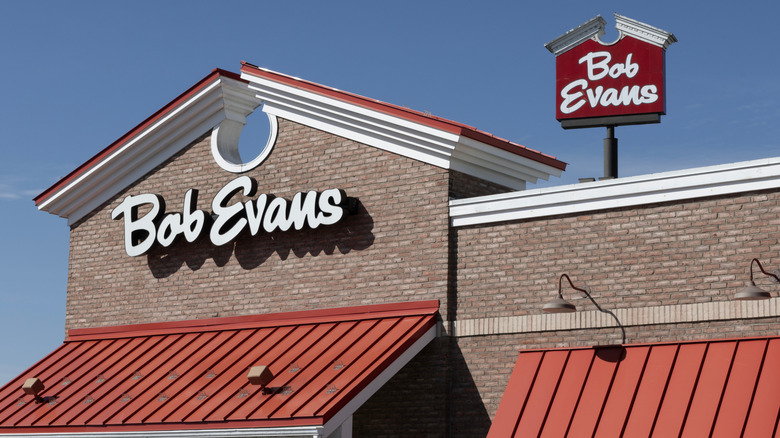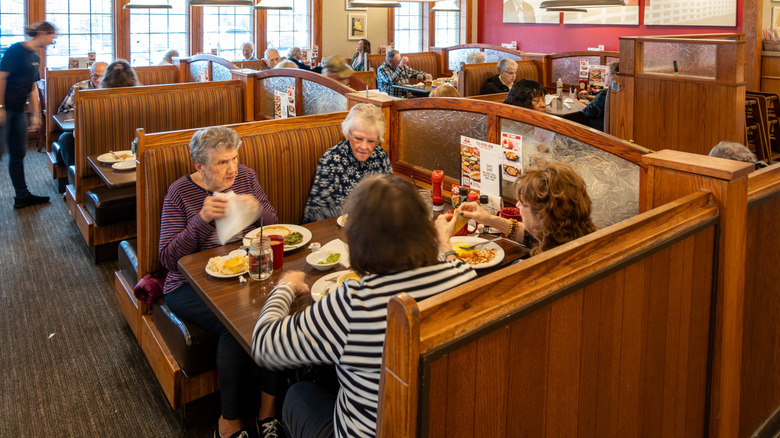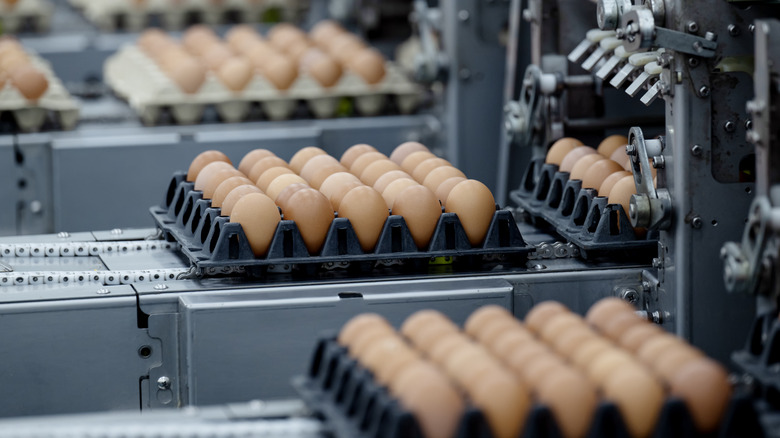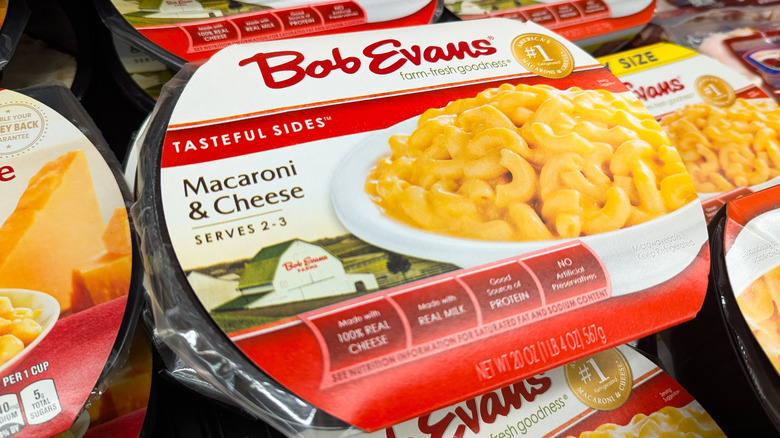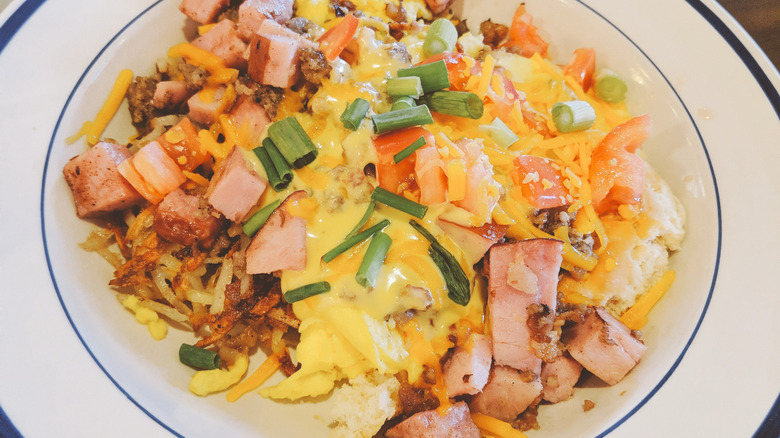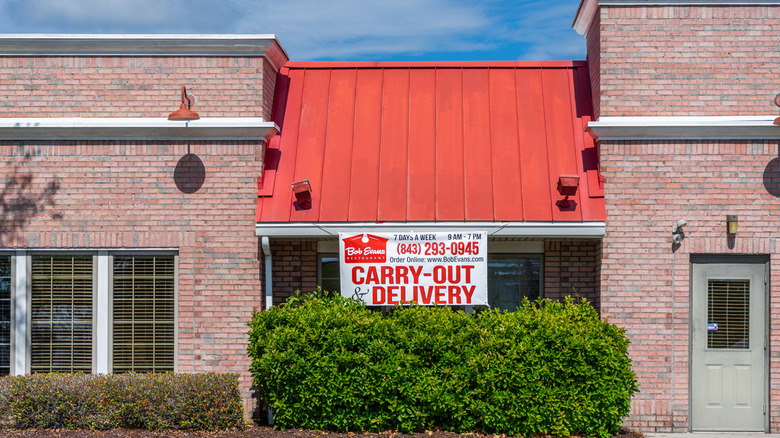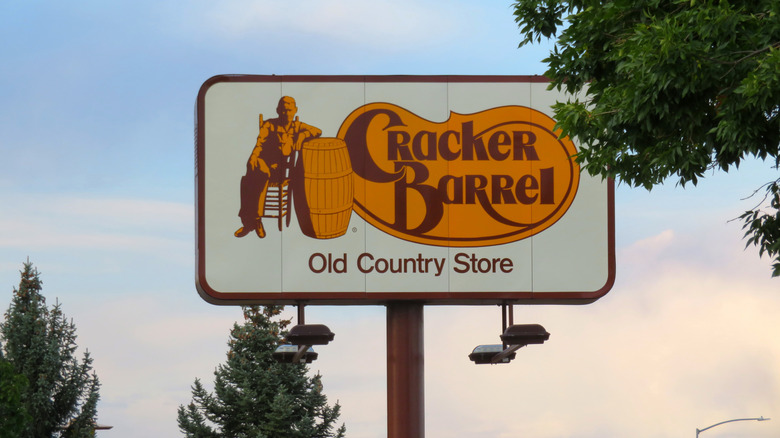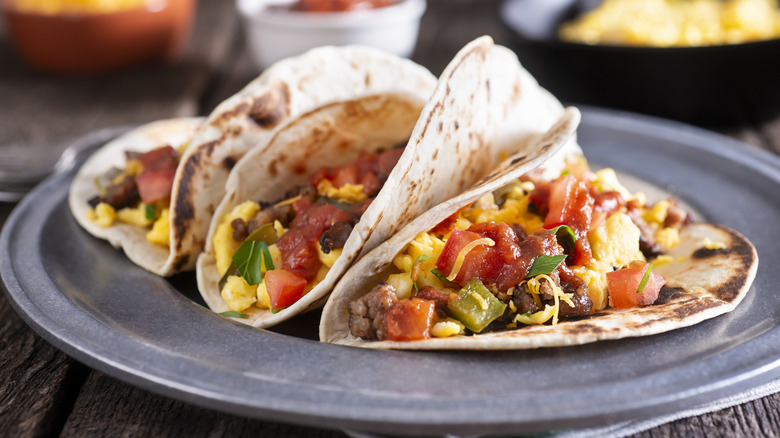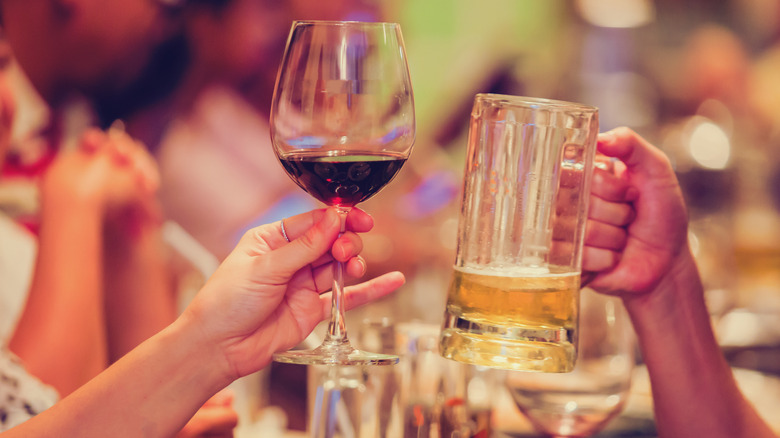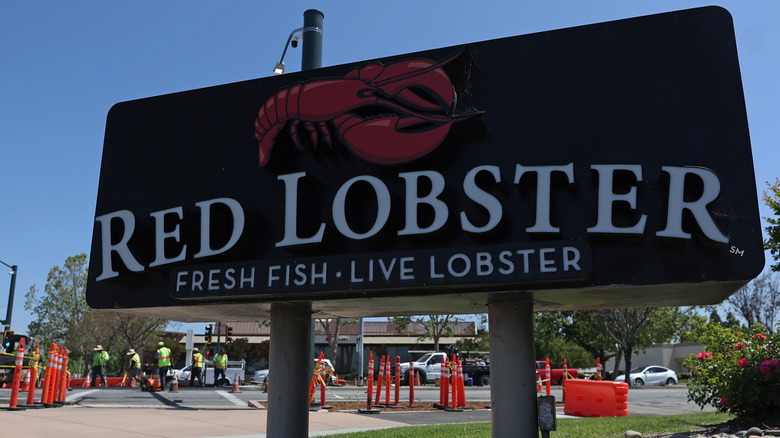12 Signs Bob Evans Is Struggling
If you're looking for a tasty, breakfast-friendly casual dining restaurant with a country flair, chances are you've heard of Bob Evans. Originally started in 1948 as an Ohio-based sausage delivery company, Bob Evans Farms opened its first brick-and-mortar location in 1962, when it was known as the Sausage Shop. From those humble beginnings, the chain has since grown to nearly 500 locations across 18 states. While it has spent decades serving a traditional homestyle menu featuring dishes such as breakfast platters, omelets, burgers, and sandwiches, the company has noticeably changed over the last several years, as has its menu.
Though Bob Evans is still one of the fast food chains where breakfast is available all day, those menu changes are just one of several signs that the company is struggling to adapt to a changing landscape, one of the many casual dining restaurants struggling to lure diners out of their homes and away from DoorDash. Here's a quick rundown of why we think Bob Evans is having a hard time these days.
It's looking to sell the company
In early 2017, private equity firm Golden Gate Capital purchased Bob Evans for $565 million. But by 2022, it was already trying to sell the company for up to $600 million. Unable to find a buyer, no sale went through. (It probably didn't help that, by 2022, the company's sales had slipped every single year since 2016.) However, in 2024, rumors spread that it was once again trying to unload the company, hiring the investment bank Kroll to find a buyer and facilitate the sale.
Now, it could just be that Golden Gate Capital is looking to sell Bob Evans to simply get a good return on its initial investment — especially since private equity firms typically sell off companies in less than five years, and 2025 marks eight years since it bought the chain. But if Bob Evans was doing particularly well, you'd think Golden Gate Capital might want to hold on to it. Either way, it's not a huge sign of confidence in the company as a whole, especially since there's been no word on any potential buyers this time.
Family dining isn't doing well in general
While a few evergreen family dining brands are still doing well these days (we're looking at you, Waffle House), family dining restaurants had a pretty poor year in 2024. Most chains averaged losses compared to the previous year's sales. Bob Evans was one of those struggling chains, having experienced a 2.7% drop in sales compared to 2023.
Admittedly, that was actually better than some other chains, with Big Boy's sales dropping by 12.4%, and Shoney's dropping by 26.8%. It probably helps that Bob Evans is more focused on takeout and delivery than some of those other chains, which has helped it cater to the growing number of customers who prefer to eat at home rather than going out. That still-growing market is one of the reasons the flourishing chain that is Waffle House started offering delivery services in 2025. But even if it's doing less business than some competitors, Bob Evans is still losing money.
Egg prices have been hitting it hard
If there's one ingredient that breakfast-focused chains like Bob Evans need in huge quantities, it's eggs. Unfortunately, eggs are one of the main reasons that these same chains have taken a big hit in recent years. Thanks in no small part to the supply concerns caused by bird flu outbreaks, egg prices reached a record high of $6.23 per dozen in March 2025. In fact, it got so bad that some chains applied an egg surcharge to some dishes, with Waffle House adding a $0.50 surcharge (which it then dropped in July 2025) and Denny's adding — and also later removing — various surcharges for different stores, working on a market-to-market basis.
Now, Bob Evans didn't go that route, and it refused to add an egg surcharge at its restaurants. However, that just means the company had to suffer through lowered profits on egg dishes, which include almost all of the restaurant's day-long breakfast offerings. That means higher per-unit costs and lower profits, company-wide. While egg prices have since fallen from February's peak pricing, they're still around 27.3% higher than last year. And that's not good news for such a heavily egg-dependent business as Bob Evans.
It's pivoting to a younger market
Bob Evans has long been associated with older customers, who presumably appreciate the chain's comfort food and casual country style. (One Reddit user described the clientele of their local Bob Evans as primarily "Romeos," which they defined as "Retired Old Men Eating Out.") The company is definitely aware of this perception, as Bob Holtcamp, Bob Evans' president and chief marketing officer, told FSR in 2023, "A lot of times people think about Bob Evans, they may think Bob Evans caters only to an older audience."
But that's a problem for the chain, as these days older customers are eating out less often, leading the company to try and pivot to a younger family demographic. As Holtcamp told FSR, "Our number one group, our biggest user is a millennial family, who thinks about food differently than the Gen X or baby boomer family did 20 or 30 years ago," Holtcamp says. "All of our innovation has been looking at what the needs are of that group and staying relevant, and that means bigger, bolder flavor." But it's hard to pivot a decades-old restaurant chain to a new, younger market, especially if your target audience associates it with their grandparents' generation.
It's getting confused with the other Bob Evans company
Only a few months after private equity firm Golden Gate Capital bought Bob Evans in 2017, it split the company into two smaller companies: Bob Evans Farms, which handles the Bob Evans-branded frozen food products, and Bob Evans Restaurants, which handles, well, the restaurants. Golden Gate Capital soon sold off Bob Evans Farms to Post Holdings, completely separating the two businesses that still share very similar names. That similarity has caused confusion with customers, with several Better Business Bureau complaints from customers focusing on the fact that the stores no longer serve Bob Evans foods, such as its frozen sausages, apparently unaware that there are now two separate Bob Evans companies.
While the Bob Evans restaurants have been struggling for the last several years, Bob Evans Farms has since become the best-selling dinner sides brand in the country. That means the Bob Evans Farms branding often gets more publicity than the restaurant company, which tends to keep things fairly low-profile in terms of advertising. That confusion isn't helping the restaurant, especially since Bob Evans Farms has been involved in potato recalls that affected millions, as well as recalls bearing the warning that there may be rubber in your Bob Evans Italian sausage. It's even tried revamping its image to be more TikTok-friendly, promoting hip new recipes like Mac 'n Mashtinis. This strategy doesn't support the restaurant's classic country style, and probably hasn't helped it find a younger demographic, either.
Some stores are closing
As of July 2025, there are almost 500 Bob Evans restaurants across the country. However, several of these locations have recently closed for good, sometimes with little or no notice to the public. For example, one 27-year-old restaurant that had operated in Midway, Delaware was closed by the Bob Evans corporate office back in April 2025, while another was abruptly shut down in Melbourne, Florida, in December 2024.
The company hasn't commented on any larger plans to close stores en masse, and these may simply be individual closures stemming from poor sales. Bob Evans has closed stores in large batches in the past, shuttering 27 stores in 2016 as part of a larger plan to improve profitability by shuttering underperforming stores. However, the chain hasn't conducted a similar round of shutdowns since then, which is actually a little surprising. After all, it was purchased by private equity group Global Gate Capital in 2017, and private equity groups are often prone to these kinds of extreme fat-trimming measures. So, will more Bob Evans restaurants hit the chopping block? As the aforementioned closures didn't get much advance notice, we'll just have to wait and see.
Its menu has become generic
While the Bob Evans brand has always been based on country cooking, it feels like the restaurant's menus have pivoted to a general American food theme in recent years, emphasizing burgers, chicken tenders, and chopped salads that could feature on almost any chain menu. This simplification of the menu was part of a corporate strategy to streamline the company, but it robbed the chain of many of its beloved country dishes and flavors. Suddenly, it seems like Bob Evans is trying to appeal to everyone, while abandoning the country theme on which the chain was built.
As an example, Bob Evans used to offer corn mush — a Midwestern recipe of fried cornmeal porridge — on its menu, with customers raving about it in reviews. However, sometime after COVID-19 hit, the company took it off the menu, with some customers claiming that corn mush was available upon request until Bob Evans seemingly dropped it for good. And while corn mush may be a vintage breakfast food no one eats anymore, it's also a lot more country than some of the chain's latest menu offerings, which include brioche French toast, a summer berry salad, and lemon garlic chicken with steak tips. Let's face it, those dishes could feature on just about any American restaurant's menu, so they're probably not the best way to set Bob Evans apart from the crowd and lure in new customers.
It's focusing on takeout over its restaurants
Over the last several years, and even before COVID-19, Bob Evans started to focus on takeout and catering deals for families. It offered to-go family meals, large platter meals, and catering boxes with huge amounts of eggs, ham, and biscuits. This move ended up helping the chain survive through lockdown, as it was able to immediately accommodate customers wanting to eat from home, unlike some of its more unprepared competitors. Even after customers started dining out again, the chain continued to focus a lot of its energy on this catering business, with a decent portion of the Bob Evans website focused on selling huge event platters like cold sandwich trays, garden salads, and turkey platters.
But while catering food might be handy for big events, it's not particularly interesting or tasty. Part of the simplified menu adopted by Bob Evans in recent years consists of smaller versions of those family meals and catering platters, like its farmhouse garden salad or chicken salad sandwich. The result is a menu that's just kind of average, without the more unique, exciting offerings that might bring in customers to the stores. After all, nobody's dining out to get a generic turkey sandwich they could find on an event tray.
Cracker Barrel is beating Bob Evans at its own game
As Bob Evans has moved away from its original country flavors, Cracker Barrel has continued to focus on the same blend of folksy style and retail presence it has always offered. Despite the similarities between the two chains, Cracker Barrel is one of those rare casual dining chains that's still doing well, with an increase of 2.9% in the first fiscal quarter of 2025 over the same period in 2024 (although we should add that the retail arm of the store was down 1.6%).
What makes the two chains different? Well, Cracker Barrel's recent menu additions have stuck closer to its country roots. New items for 2025 include a chicken and dumpling soup and chicken tenders with Nashville hot sauce. It probably also doesn't help that some feel like Cracker Barrel's food quality is just plain better than Bob Evans, with a stronger breakfast lineup and a wider variety of dishes. That said, it's not all perfect at the "old country store." Thanks to an ongoing mass revamp, your local Cracker Barrel might start looking a lot different (and not in a good way). Watch this space to see if it continues to outperform Bob Evans.
Bob Evans is branching out into tacos
Speaking of new menu items, Bob Evans announced a string of new menu additions in early 2025, and its latest big push is, surprisingly, tacos. Now, the chain isn't fully embracing Mexican-inspired cuisine — it'll just be serving breakfast tacos — but that's still not exactly the market that Bob Evans is known for. Also, it's already a pretty crowded market, as you can find breakfast tacos all over nowadays. It sure seems like this move is more about offering an easy breakfast item that also easily translates to a catering menu, with the Double Meat Breakfast Taco Bar also introduced as a catering option.
This isn't the first time Bob Evans has tried branching into new menu territories. Back in 2010, Bob Evans specifically tried to take on the pizza market with its lineup of takeout family meals, telling patrons to "Think outside the pizza box," and offering discounts to customers who brought in pizza coupons (via Pizza Marketplace). While Bob Evans still offers family meals to go (and those takeout family meals definitely helped the chain survive the early 2020s), it wasn't able to become a significant competitor in the pizza market. The campaign ended up being short-lived, with pizza no longer listed on the chain's website.
Bob Evans started selling alcohol at some restaurants
In 2021, Bob Evans started adding beer and wine to its Florida locations, and applying for liquor licenses in Indiana. It was also reported that it had introduced alcohol to restaurants in West Virginia and had plans to do the same in Ohio. When asked about the move, its then-CEO Saed Mohseni told NBC, "We're not going to be a bar business, obviously. But we want there to be an option for those who want it. Some guests might not even notice that we have alcohol."
While it may not necessarily fit with its traditional family-friendly vibe, we can see why a chain like Bob Evans might want to give customers the option to drink. However, the rollout of alcohol at its restaurants has proven a little confusing. It's unclear if the chain ever moved forward with a company-wide launch. Bob Evans also doesn't list any alcoholic beverages on its online menus, so it's hard to conclude if its plans to increase foot traffic via booze were met with great success.
Its parent company doesn't have the best track record
Remember that company that (currently) owns Bob Evans, Golden Gate Capital? Well, it doesn't exactly have the best track record with managing restaurants. Golden Gate Capital previously owned the chain California Pizza Kitchen, which filed for bankruptcy in 2020 and has spent the subsequent years trying to improve its profitability. It also owned Red Lobster, another restaurant chain that filed for bankruptcy in 2024.
Golden Gate Capital's business practices contributed to Red Lobster's financial troubles, as after buying the brand for $2.1 billion, it swiftly sold off Red Lobster's real-estate holdings for $1.5 billion to American Realty Company. That move forced Red Lobster restaurants to lease locations from that company, with built-in rent increases. When all that new debt was combined with underperforming stores, it spelled disaster for the company.
While Golden Gate Capital didn't own Red Lobster when it went bankrupt — in 2020, it sold its stake in the company to Thai Union Group, a group of investors and a seafood supplier — its decision to sell the company to that specific buyer didn't have the best consequences. Thai Union didn't have much experience running a restaurant company and ended up turning Red Lobster's iconic limited-time unlimited shrimp promotion into a permanent fixture of the menu, which ultimately forced the company into the red.
